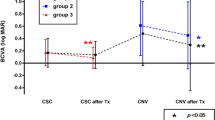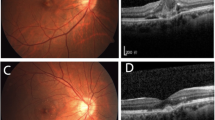Abstract
Purpose
To describe the clinical features, management, and outcomes of choroidal neovascularization (CNV) in children less than 18 years of age.
Methods
This was a retrospective, case control study of 111 eyes of 96 patients. CNV was clinically diagnosed in all patients. Eyes were classified as those that were observed (Controls; Group 1) or those that had treatment (Cases; Group 2). CNV was categorized as regressed, persistent, or recurrent in order to evaluate the anatomical outcomes.
Results
Of 96 patients, 68(71%) were male. Mean presenting age was 11.4 ± 3.4 years (median = 11 years, range = 1–17 years). CNV was bilateral in 15(16%) patients. Of 111 eyes, 38 eyes had treatment (Cases) and 73 eyes did not (Natural history group or Controls). Subfoveal CNV was seen in majority of cases (59%). Most common etiology was post-inflammatory (38%), followed by trauma (16%). Eyes were classified as those that were observed (controls; Group 1) or those that had treatment (cases; Group 2). In group 1, spontaneous regression of CNV was seen in 26(36%) eyes and there was no recurrence in this group. In group 2 following treatment, 25(66%) of 38 eyes achieved complete regression at mean 4.9 months and was persistent in 5 eyes. CNV recurrence was seen in 10 eyes with the mean time to first recurrence being 9 months. At presentation, mean best-corrected visual acuity (BCVA) of eyes with subfoveal CNV was logMAR 0.99 that improved to logMAR 0.63 with treatment. Mean follow-up was 17 months.
Conclusion
CNV results in significant visual decline in children; most commonly of post-inflammatory etiology. Treatment achieves high regression rates, albeit with limited visual improvement.




Similar content being viewed by others
Data availability
The data pertaining to this research can be submitted upon request from the corresponding author.
References
Wilson ME, Mazur DO (1988) Choroidal neovascularization in children: report of five cases and literature review. J Pediatr Ophthalmol Strabismus 25:23–29
Kozak I, Mansour A, Diaz RI et al (2014) Outcomes of treatment of pediatric choroidal neovascularization with intravitreal antiangiogenic agents. Retina 34:2044–2052
Gilbert C, Foster A, Negrel AD, Thylefor B (1993) Childhood blindness: a new form for recording causes of visual loss in children. Bull World Health Organ 71:485–489
World Health Organization (2001) Report of WHO/IAPB Scientific Meeting, Childhood Blindness Prevention. WHO/PBL/87:London
Spraul CW, Grossniklaus HE (1997) Characteristics of Drusen and Bruch’s membrane in postmortem eyes with age-related macular degeneration. Arch Ophthalmol 115:267–273
Melberg NS, Thomas MA, Burgess DB (1996) The surgical removal of subfoveal choroidal neovascularization. Ingrowth site as a predictor of visual outcome. Retina 16:190–195
Gass JD (1994) Biomicroscopic and histopathologic considerations regarding the feasibility of surgical excision of subfoveal neovascular membranes. Am J Ophthalmol 118:285–298
Spaide RF (1999) Choroidal neovascularization in younger patients. Curr Opin Ophthalmol 10:177–181
Cohen SY, Laroche A, Leguen Y, Soubrane G, Coscas GJ (1996) Etiology of choroidal neovascularization in young patients. Ophthalmology 103:1241–1244
Sivaprasad S, Moore AT (2008) Choroidal neovascularization in children. Br J Ophthalmol 92:451–454
Rishi P, Gupta A, Rishi E, Shah BJ (2013) Choroidal neovascularization in 36 eyes of children and adolescents. Eye (Lond) 27(10):1158–1168
Mavrikakis E, Levin AV, Lam WC (2010) Choroidal neovascularization secondary to congenital toxoplasmosis in an infant. Can J Ophthalmol 45:e11–e12
Padhi TR, Anderson BJ, Abbey AM, Yonekawa Y, Stem M, Alam D, Modi RR, Savla LP, Trese MT, Capone A, Drenser KA, Besirli CG (2018) Choroidal neovascular membrane in pediatric patients: clinical characteristics and outcomes. Br J Ophthalmol 102(9):1232–1237
Christmas NJ, Oh KT, Oh DM, Folk JC (2002) Long-term follow-up of patients with serpiginous choroiditis. Retina 22:550–556
Gupta V, Agarwal A, Gupta A, Bambery P, Narang S (2002) Clinical characteristics of serpiginous choroidopathy in North India. Am J Ophthalmol 134:47–56
Farah ME, Costa RA, Muccioli C, Guia TA, Belfort R Jr (2002) Photodynamic therapy with verteporfin for choroidal neovascularization in Vogt-Koyanagi-Harada syndrome. Am J Ophthalmol 134:137–139
Rishi P, Venkataraman A, Rishi E (2011) Combination photodynamic therapy and bevacizumab for choroidal neovascularization associated with toxoplasmosis. Indian J Ophthalmol 59:62–64
Veloso CE, Costa RA, Ore´fice JL, Ore´fice F (2007) Spontaneous involution of choroidal neovascularization secondary to rubella retinopathy. Eye (Lond) 21:1429–1430
Viola F, Villani E, Mapelli C, Staurenghi G, Ratiglia R (2010) Bilateral juvenile choroidal neovascularization associated with Best’s vitelliform dystrophy: observation versus photodynamic therapy. J Pediatr Ophthalmol Strabismus 47:121–122
Barth T, Zeman F, Helbig H, Oberacher-Velten I (2016) Etiology and treatment of choroidal neovascularization in pediatric patients. Eur J Ophthalmol 26(5):388–393
Potter MJ, Szabo SM, Ho T (2006) Combined photodynamic therapy and intravitreal triamcinolone for the treatment of myopic choroidal neovascularization in a 13-year-old girl. Graefes Arch Clin Exp Ophthalmol 244:639–641
Harissi-Dagher M, Sebag M, Gauthier D, Marcil G, Labelle P, Arbour JD (2005) Photodynamic therapy in young patients with choroidal neovascularization following traumatic choroidal rupture. Am J Ophthalmol 139:726–728
Prasad A, Chirag CP, Puklin JE (2009) Intravitreal bevacizumab in the treatment of choroidal neovascularization from a traumatic choroidal rupture in a 9-year-old child. Retinal Case Brief Rep 3:125–127
Klein R, Lewis RA, Meyers SM, Myers FL (1978) Subretinal neovascularization associated with fundus flavimaculatus. Arch Ophthalmol 96:2054–2057
Endo K, Yuzawa M, Ohba N (2000) Choroideremia associated with subretinal neovascular membrane. Acta Ophthalmol Scand 78:483–486
Rhee DY, Reichel E, Rogers A, Strominger M (2007) Subfoveal choroidal neovascularization in a 3-year-old child with North Carolina macular dystrophy. J AAPOS 11:614–615
Mahajan VB, Russell SR, Stone EM (2009) A new macular dystrophy with anomalous vascular development, pigment spots, cystic spaces, and neovascularization. Arch Ophthalmol 127:1449–1457
Uemura A, Thomas MA (2000) Visual outcome after surgical removal of choroidal neovascularization in pediatric patients. Arch Ophthalmol 118:1373–1378
Mehta P, Puri P, Talbot JF (2006) Disc drusen and peripapillary subretinal neovascular membrane in a child with the VACTERL association. Eye (Lond) 20:847–848
Nguyen C, Borruat FX (2005) Bilateral peripapillary subretinal neovascular membrane associated with chronic papilledema: report of two cases. Klin Monatsbl Augenheilkd 222:275–278
Anderson CJ, Zavel DW, Schlagel TF Jr, Meyer SM (1978) Bilateral juxtapapillary subretinal neovascularization and pseudopapilledema in a three-year old child. J Pediatr Ophthalmol Strabismus 15:296–299
Kaeser PF, Borruat FX (2011) Peripapillary neovascular membrane: a rare cause of acute vision loss in pediatric idiopathic intracranial hypertension. J AAPOS 15:83–86
Browning AC, Mengher LS, Gregson RM, Amoaku WM (2001) Visual outcome of malignant hypertension in young people. Arch Dis Child 85:401–403
Yıldırım C, Cetin EN, Yayla K, Avunduk AM, Yaylalı V (2011) Photodynamic therapy for unilateral idiopathic peripapillary choroidal neovascularization in a child. Int Ophthalmol 31:333–335
Yedavally S, Frank RN (1993) Peripapillary subretinal neovascularization associated with coloboma of the optic nerve. Arch Ophthalmol 111:552–553
Neri P, Pichi F, Pirani V, Arapi I (2020) Systemic immunosuppression is highly effective in the long-term control of inflammatory non-infectious uveitic choroidal neovascularization: a comparative study. Ocul Immunol Inflamm 7:1–5
Neri P, Manoni M, Fortuna C, Lettieri M, Mariotti C, Giovannini A (2010) Association of systemic steroids and mycophenolate mofetil as rescue therapy for uveitic choroidal neovascularization unresponsive to the traditional immunosuppressants: interventional case series. Int Ophthalmol 30(5):583–590
Neri P, Mercanti L, Mariotti C, Salvolini S, Giovannini A (2010) Long-term control of choroidal neovascularization in quiescent congenital toxoplasma retinochoroiditis with photodynamic therapy: 4-year results. Int Ophthalmol 30(1):51–56
Giovannini A, Neri P, Mercanti L, Bruè C (2007) Photodynamic treatment versus photodynamic treatment associated with systemic steroids for idiopathic choroidal neovascularization. Br J Ophthalmol 91(5):620–623
Wu Q, Chen X, Feng K, Liu Y, Zhang C, Zhao L (2020) Evaluation of efficacy and recurrence for anti-vascular endothelial growth factor therapy in idiopathic choroidal neovascularization. BMC Ophthalmol 20(1):115
Chen SN, Chen YL, Yang BC (2020) Long-term outcome of punctate inner choroidopathy or multifocal choroiditis with active choroidal neovascularization managed with intravitreal bevacizumab. Ocul Immunol Inflamm 28(1):33–38
Parodi MB, Iacono P, Da Pozzo S (2020) Anti-VEGF and Retinal Dystrophies. Curr Drug Targets 21(12):1201–1207
Saitta A, Nicolai M, Neri P, Reibaldi M, Giovannini A, Mariotti C (2015) Rescue therapy with intravitreal aflibercept for choroidal neovascularization secondary to choroidal osteoma non-responder to intravitreal bevacizumab and ranibizumab. Int Ophthalmol 35(3):441–444
Funding
No funding was received for this research. The authors declare no financial interest.
Author information
Authors and Affiliations
Consortia
Contributions
Conceptualization and Methodology PR, Formal analysis and investigation PR, RPKB, ER, Writing—original draft preparation RKB, Writing—review and editing PR, RPKB, ER, MB, JB, AA, SS.
Corresponding author
Ethics declarations
Conflicts of interest
The authors declare that they have no conflict of interest.
Ethical approval
IRB approval was obtained (Ethics subcommittee, Vision Research Foundation, Chennai, India. 20190810). The authors declare that they have no ethical conflicts to disclose.
Consent to participate
Informed consent was obtained from all study participants.
Consent for publication
Consent obtained from all co-authors for publication.
Additional information
Publisher's Note
Springer Nature remains neutral with regard to jurisdictional claims in published maps and institutional affiliations.
Supplementary Information
Below is the link to the electronic supplementary material.
Rights and permissions
About this article
Cite this article
Rishi, P., Bharat, R.P.K., Rishi, E. et al. Choroidal neovascularization in 111 eyes of children and adolescents. Int Ophthalmol 42, 157–166 (2022). https://doi.org/10.1007/s10792-021-02018-2
Received:
Accepted:
Published:
Issue Date:
DOI: https://doi.org/10.1007/s10792-021-02018-2




